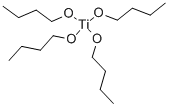Titanium standard , 1000ug/mlin1.0mol/LHNO3andtr.HF , 7440-32-6
CAS NO.:7440-32-6
Empirical Formula: Ti
Molecular Weight: 47.87
MDL number: MFCD00011264
EINECS: 231-142-3
PRODUCT Properties
| Melting point: | 1660 °C (lit.) |
| Boiling point: | 3287 °C (lit.) |
| Density | 4.5 g/mL at 25 °C (lit.) |
| bulk density | 1260kg/m3 |
| Flash point: | 0°C |
| storage temp. | no restrictions. |
| form | wire |
| color | Silver-gray |
| Specific Gravity | 4.5 |
| PH | 5-8 (50g/L in H2O, suspension) |
| Flame Color | Silver-white |
| Resistivity | 42.0 μΩ-cm, 20°C |
| Water Solubility | Insoluble in water. |
| Merck | 13,9547 |
| Exposure limits | ACGIH: TWA 2.5 mg/m3 NIOSH: IDLH 250 mg/m3 |
| Stability: | Stable. Dust is thought to be spontaneously flammable, and may form an explosive mixture with air. Flammable solid. Incompatible with mineral acids, halogens, carbon dioxide, strong oxidizing agents. |
| Cosmetics Ingredients Functions | ABSORBENT LIGHT STABILIZER |
| InChIKey | RTAQQCXQSZGOHL-UHFFFAOYSA-N |
| Hardness, Vickers | 60 |
| Modulus of Elasticity | 116 GPa |
| Poissons Ratio | 0.34 |
| Hardness, Brinell | 70, electrolytic Ti |
| Shear Modulus | 43.0 GPa, calculated |
| CAS DataBase Reference | 7440-32-6(CAS DataBase Reference) |
| EPA Substance Registry System | Titanium (7440-32-6) |
Description and Uses
Titanium was discovered by the Reverend William Gregor in 1791, and is named after the ‘Titans’ of Greek mythology. The metal was not isolated in a pure state until 1910, and useful quantities were not available for industrial applications until 1946, when an economical purification process was developed.
As alloy with copper and iron in titanium bronze; as addition to steel to impart great tensile strength; to aluminum to impart resistance to attack by salt solutions and by organic acids; to remove traces of oxygen and nitrogen from incandescent lamps. Surgical aid (fracture fixation).
Safety
| Symbol(GHS) |  GHS02 |
| Signal word | Danger |
| Hazard statements | H228 |
| Precautionary statements | P210-P240-P241-P280-P370+P378 |
| Hazard Codes | F,Xi |
| Risk Statements | 20/21/22-11-17-36/38 |
| Safety Statements | 16-36/37/39-33-27-26-6-43 |
| RIDADR | UN 2878 4.1/PG 3 |
| WGK Germany | 3 |
| RTECS | XR1700000 |
| F | 10 |
| Autoignition Temperature | 860 °F |
| TSCA | Yes |
| HazardClass | 4.2 |
| PackingGroup | III |
| HS Code | 81089020 |
| Hazardous Substances Data | 7440-32-6(Hazardous Substances Data) |
| Limited Quantities | 5.0 Kg (11 lbs) (solid) |
| Excepted Quantities | Forbidden |



![DICHLORO[RAC-ETHYLENEBIS(4,5,6,7-TETRAHYDRO-1-INDENYL)]TITANIUM(IV)](https://img.chemicalbook.com/CAS/GIF/112531-75-6.gif)

